Create an engaging, hands-on learning space with these 20 inspiring school garden ideas. From raised vegetable beds and pollinator-friendly flower patches to sensory gardens and composting stations, each design fosters curiosity and environmental awareness. These outdoor classrooms help students connect science, sustainability, and healthy eating through real-world experience. Whether your school has a large field or a small courtyard, creative layouts can maximize space and encourage collaboration. Incorporate themed gardens, weather stations, or art features to spark creativity and cross-curricular learning. With the right planning, a school garden becomes a vibrant hub for education, wellness, and community involvement.
1. School Garden Science Laboratory Ecosystem
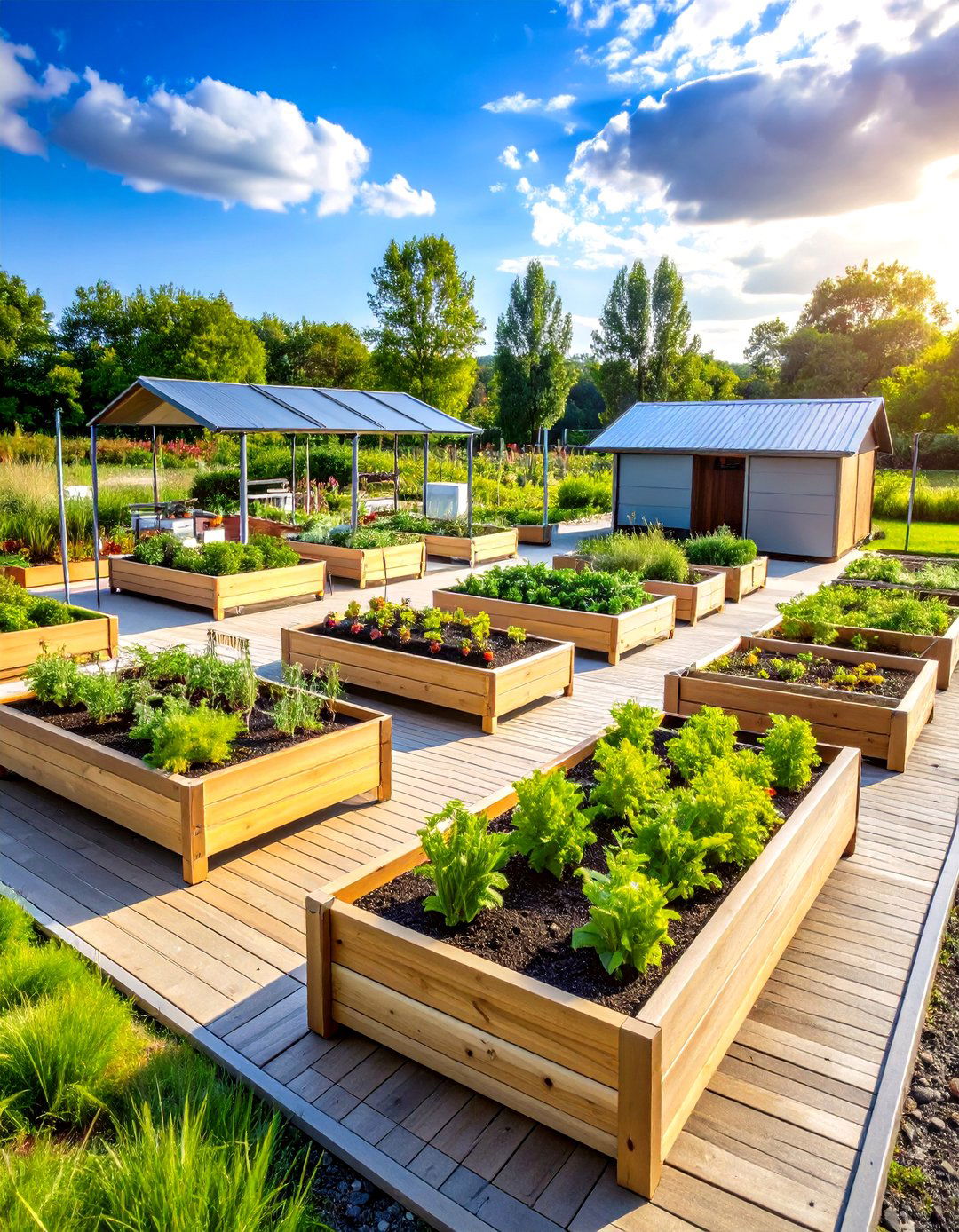
Transform your outdoor space into a living laboratory where students conduct real-time botanical experiments and observe scientific principles firsthand. This school garden design features designated research plots with controlled growing conditions, measurement stations, and data collection areas. Students plant identical seeds in different soil types, lighting conditions, and watering schedules to study plant growth variables. Install weather monitoring equipment, pH testing stations, and microscope areas for detailed plant observation. Create labeled specimen beds showcasing plant anatomy, photosynthesis demonstrations, and soil composition studies. Include compost bins to teach decomposition cycles and nutrient systems. This scientific approach turns gardening into hands-on STEM education where students develop hypothesis-testing skills and learn to document their findings through garden journals and growth charts.
2. School Garden Cultural Heritage Discovery Space

Design an educational garden that celebrates diverse cultural traditions and introduces students to plants from around the world. This school garden concept features themed sections representing different countries and cultures, showcasing traditional crops, herbs, and flowers used in various cuisines and customs. Create Mexican corn and bean plots, Asian herb gardens with bok choy and cilantro, Mediterranean sections with basil and tomatoes, and African heritage beds featuring okra and sweet potatoes. Install informational signs explaining the cultural significance of each plant and how different communities have used them throughout history. Include cooking areas where students can prepare traditional dishes using their harvests. This multicultural approach promotes global awareness while teaching students about agricultural diversity, immigration stories, and the importance of food in cultural identity and community traditions.
3. School Garden Pollinator Paradise Habitat
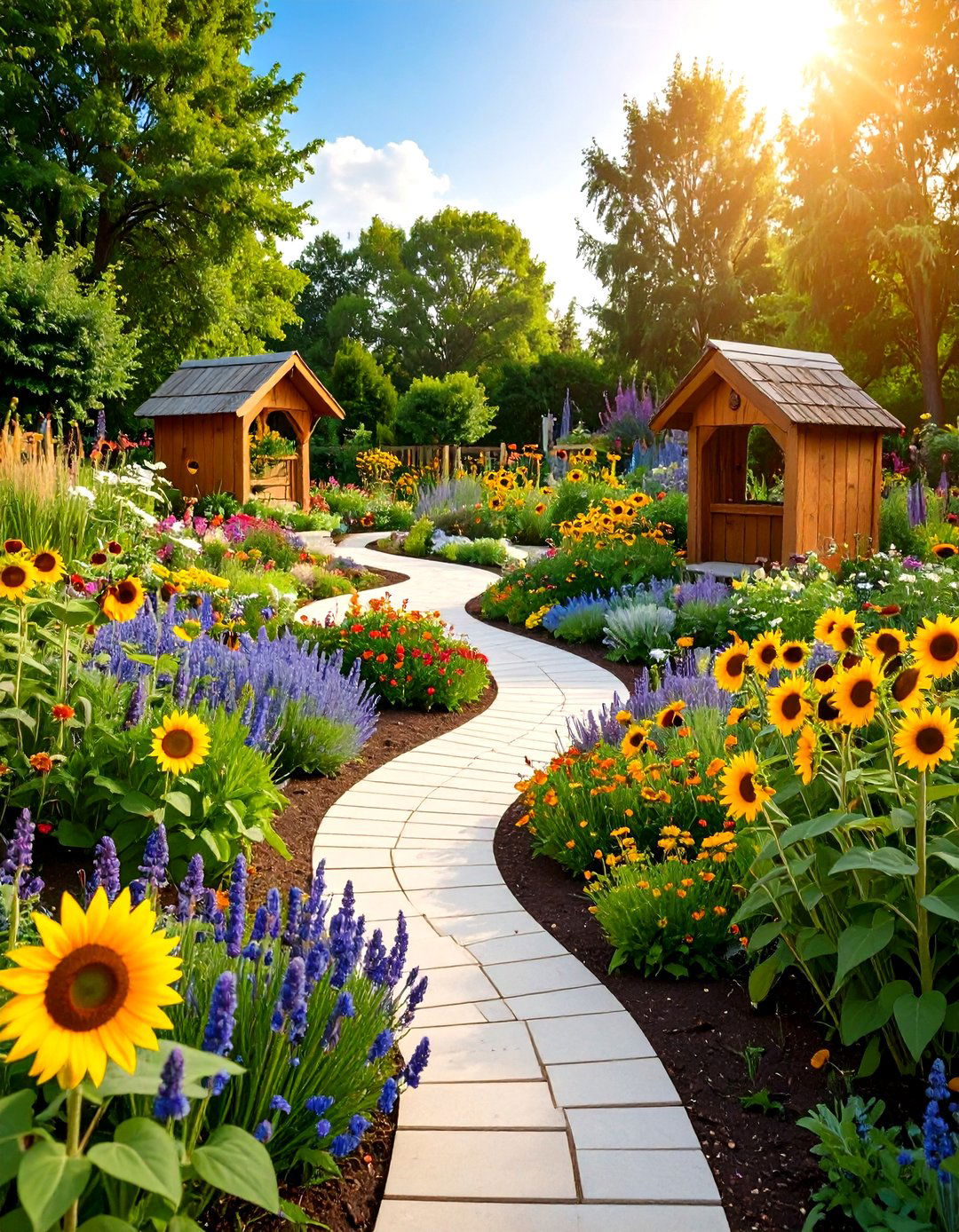
Establish a vibrant ecosystem designed specifically to attract and support local pollinators while teaching students about biodiversity and environmental interdependence. This school garden design emphasizes native flowering plants, bee-friendly herbs, and butterfly host plants arranged in colorful, naturalistic patterns. Include sunflowers, lavender, coneflowers, and other nectar-rich plants that bloom throughout the growing season. Create observation stations with magnifying equipment for studying insect behavior and pollination processes. Install bee houses, butterfly landing spots, and water features to support pollinator lifecycles. Design meandering pathways that allow students to move quietly through the space without disturbing wildlife. Add educational signage explaining pollinator roles in food production and ecosystem health. This living classroom demonstrates environmental stewardship while providing hands-on lessons about plant-animal relationships, biodiversity conservation, and the critical role pollinators play in global food systems.
4. School Garden Sensory Exploration Adventure
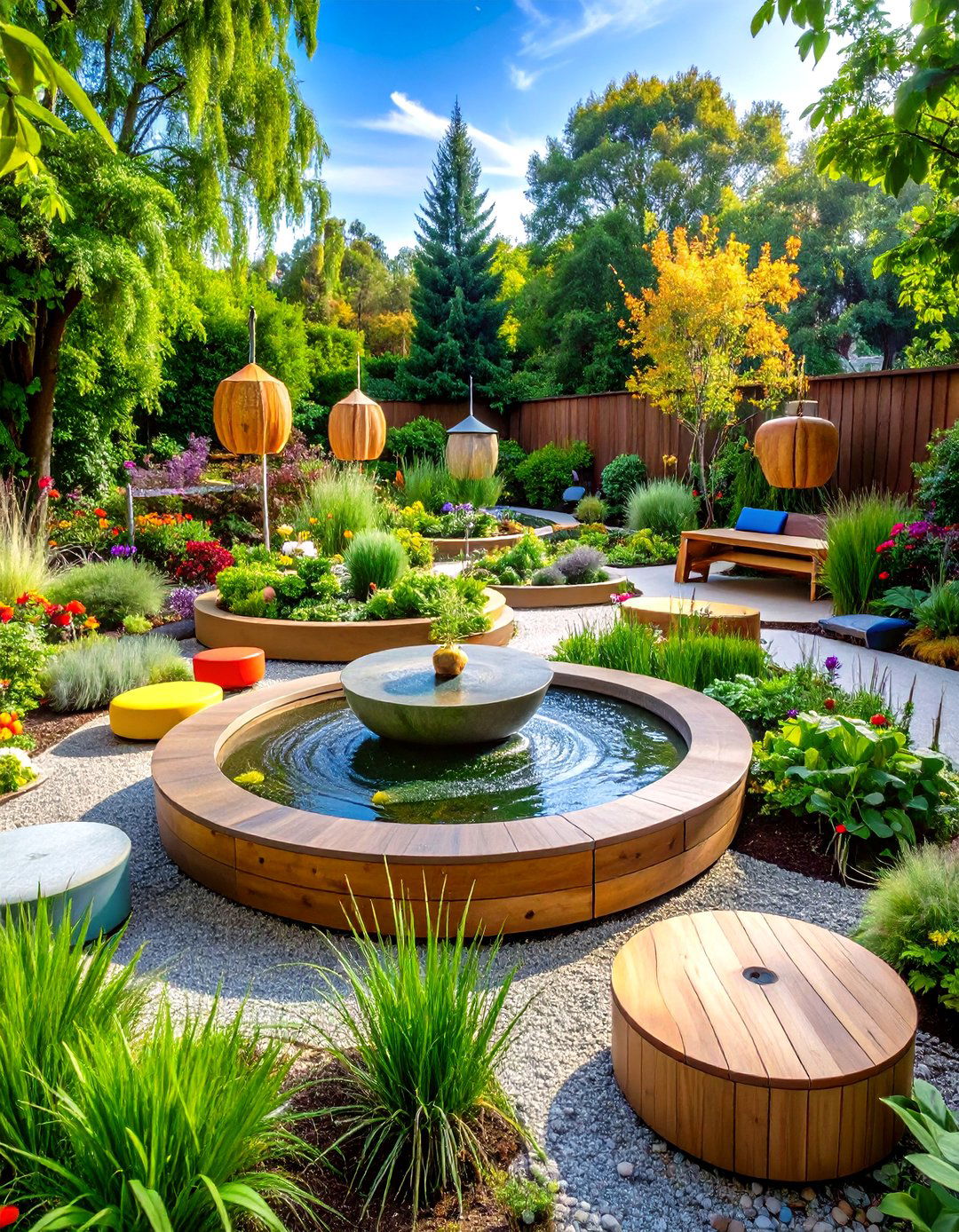
Create an immersive garden experience that engages all five senses while supporting diverse learning styles and abilities. This school garden design features plants specifically chosen for their textures, scents, sounds, tastes, and visual appeal. Include fuzzy lamb's ear for touching, aromatic herbs like mint and rosemary for smelling, ornamental grasses that rustle in the wind for listening, edible flowers and herbs for tasting, and colorful vegetables for visual stimulation. Design raised beds at various heights to accommodate wheelchair users and create tactile pathways with different ground materials. Install wind chimes, water features, and textured garden sculptures that provide additional sensory experiences. Include quiet reflection areas with comfortable seating where students can process their sensory discoveries. This inclusive design serves students with special needs while enriching the learning experience for all participants through multi-sensory engagement with nature.
5. School Garden Pizza Growing Kitchen

Transform learning into a delicious adventure by creating a garden specifically designed to grow all the ingredients needed for homemade pizza. This school garden concept features circular or wedge-shaped beds that mirror pizza slices, with each section dedicated to different pizza ingredients. Plant tomatoes for sauce, basil and oregano for seasoning, bell peppers and onions for toppings, and wheat if space allows for understanding flour production. Include a small outdoor kitchen area with pizza ovens or portable cooking equipment where students can prepare their harvest. Create measurement stations for learning about quantities, fractions, and recipe calculations. Install herb drying areas and food preservation equipment to extend the growing season. This thematic approach connects agriculture to nutrition education while teaching students about food origins, cooking skills, and the satisfaction of eating what they grow. The pizza theme makes learning memorable and provides clear connections between garden work and real-world applications.
6. School Garden Three Sisters Indigenous Heritage
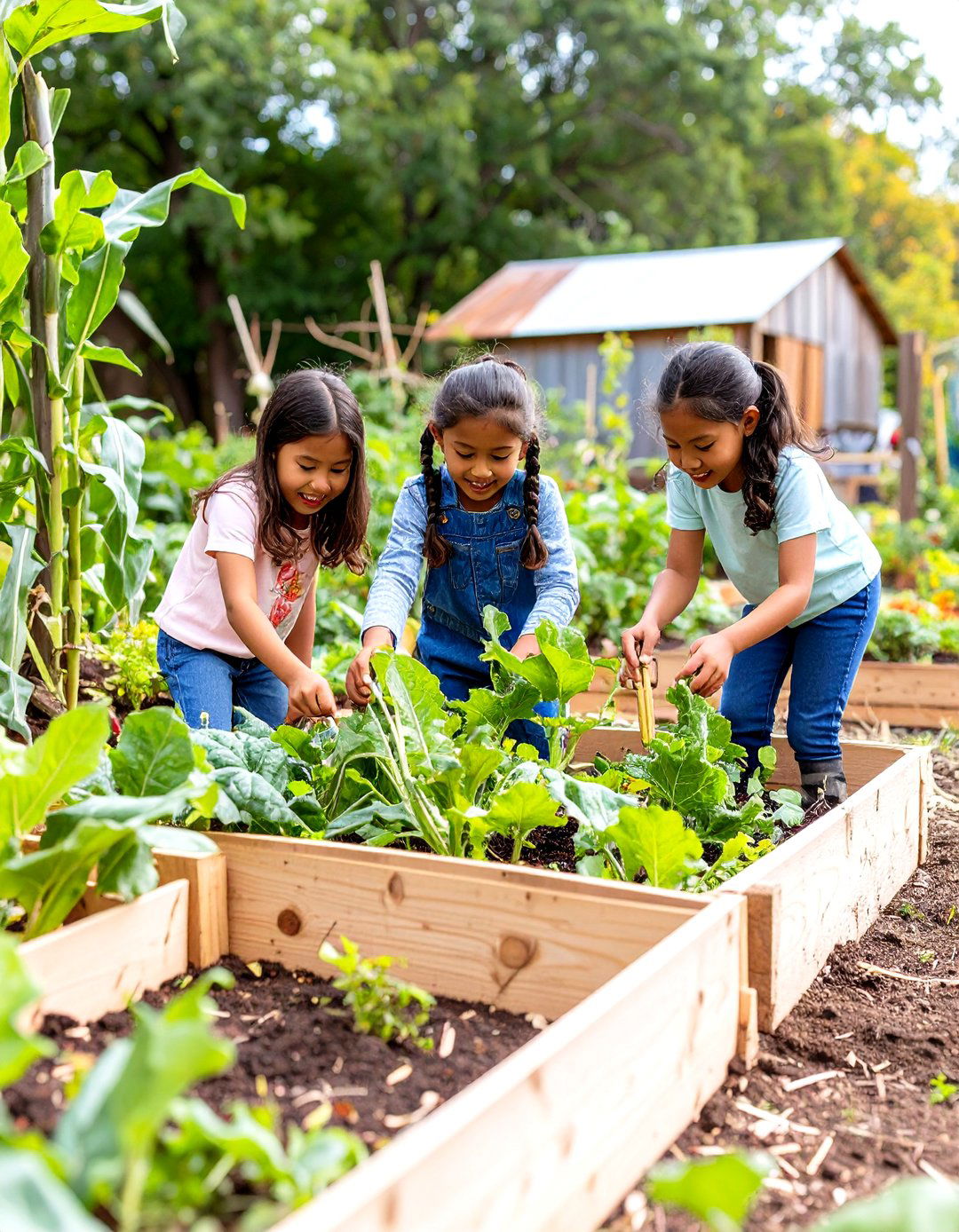
Honor Native American agricultural traditions by creating a garden based on the ancient Three Sisters planting method of corn, beans, and squash. This school garden design teaches sustainable growing practices while connecting students to indigenous wisdom and land stewardship principles. Plant corn stalks as natural support structures for climbing bean plants, while squash spreads across the ground to retain moisture and suppress weeds. Create ceremonial gathering spaces within the garden for storytelling and cultural education about Native American traditions and environmental relationships. Include interpretive materials explaining how this companion planting method benefits all three crops through nitrogen fixing, natural pest control, and efficient space utilization. Add native medicinal and ceremonial plants used by indigenous peoples. This design demonstrates permaculture principles while fostering respect for indigenous knowledge, sustainable agriculture practices, and the historical connections between people and land that predate modern farming methods.
7. School Garden Vertical Container Innovation

Maximize limited space through creative vertical growing systems that demonstrate innovative urban agriculture techniques. This school garden design utilizes walls, fences, and vertical structures to create multi-level growing environments using containers, hanging planters, and tower systems. Install recycled tire planters, pallet gardens, bottle planters, and purpose-built vertical growing systems that students can construct and maintain. Include drip irrigation systems that teach water conservation and efficient growing methods. Create mobile container gardens that can be moved based on seasonal light conditions or indoor/outdoor requirements. Feature plants suited to container growing such as herbs, lettuce, strawberries, and cherry tomatoes. This space-efficient approach works perfectly for urban schools with limited outdoor areas while teaching students about modern agricultural innovations, resource conservation, and problem-solving through creative design. Students learn engineering principles while growing food in sustainable, replicable systems.
8. School Garden Hydroponic Innovation Laboratory

Introduce students to soil-free growing methods through a comprehensive hydroponic garden that demonstrates advanced agricultural technology. This school garden design features both simple and sophisticated hydroponic systems including deep water culture, nutrient film technique, and aeroponic towers. Create educational stations explaining how plants absorb nutrients, the role of pH in plant health, and water cycle management. Include monitoring equipment for tracking plant growth rates, nutrient levels, and environmental conditions. Design the space with transparent growing containers so students can observe root development and nutrient uptake. Install LED growing lights for year-round cultivation and climate-controlled growing areas. This high-tech approach teaches students about modern agriculture innovations, sustainable farming practices, and food security solutions. Students learn about water conservation, nutrient cycling, and precision agriculture while growing fresh produce regardless of weather conditions or soil quality limitations.
9. School Garden Butterfly Life Cycle Observatory
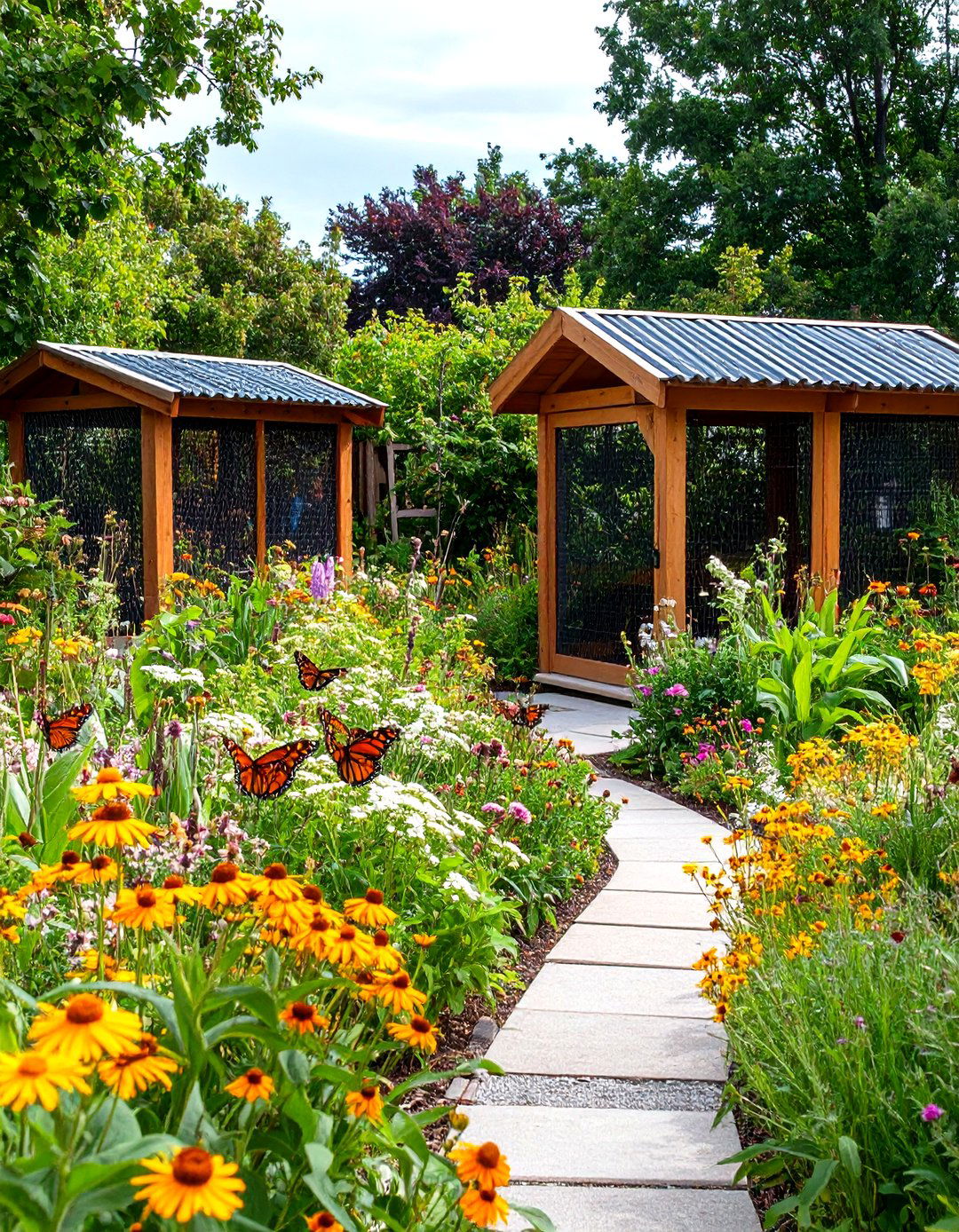
Design a specialized garden that supports complete butterfly lifecycles while providing students with opportunities to observe metamorphosis and insect biology. This school garden concept includes host plants for caterpillars, nectar sources for adult butterflies, and observation areas for studying insect development. Plant species like milkweed for monarch butterflies, parsley for swallowtails, and native wildflowers for various butterfly species. Create enclosed butterfly observation areas with mesh structures where students can safely watch chrysalis formation and emergence. Install magnification stations and documentation areas for recording butterfly behavior and lifecycle stages. Include seasonal planting schedules that provide continuous blooms throughout the growing season. Add water features and butterfly puddling stations that provide essential minerals. This living laboratory teaches students about biological processes, ecosystem relationships, and conservation practices while creating a beautiful, dynamic outdoor classroom that changes throughout the seasons.
10. School Garden Rain Collection Sustainability Center
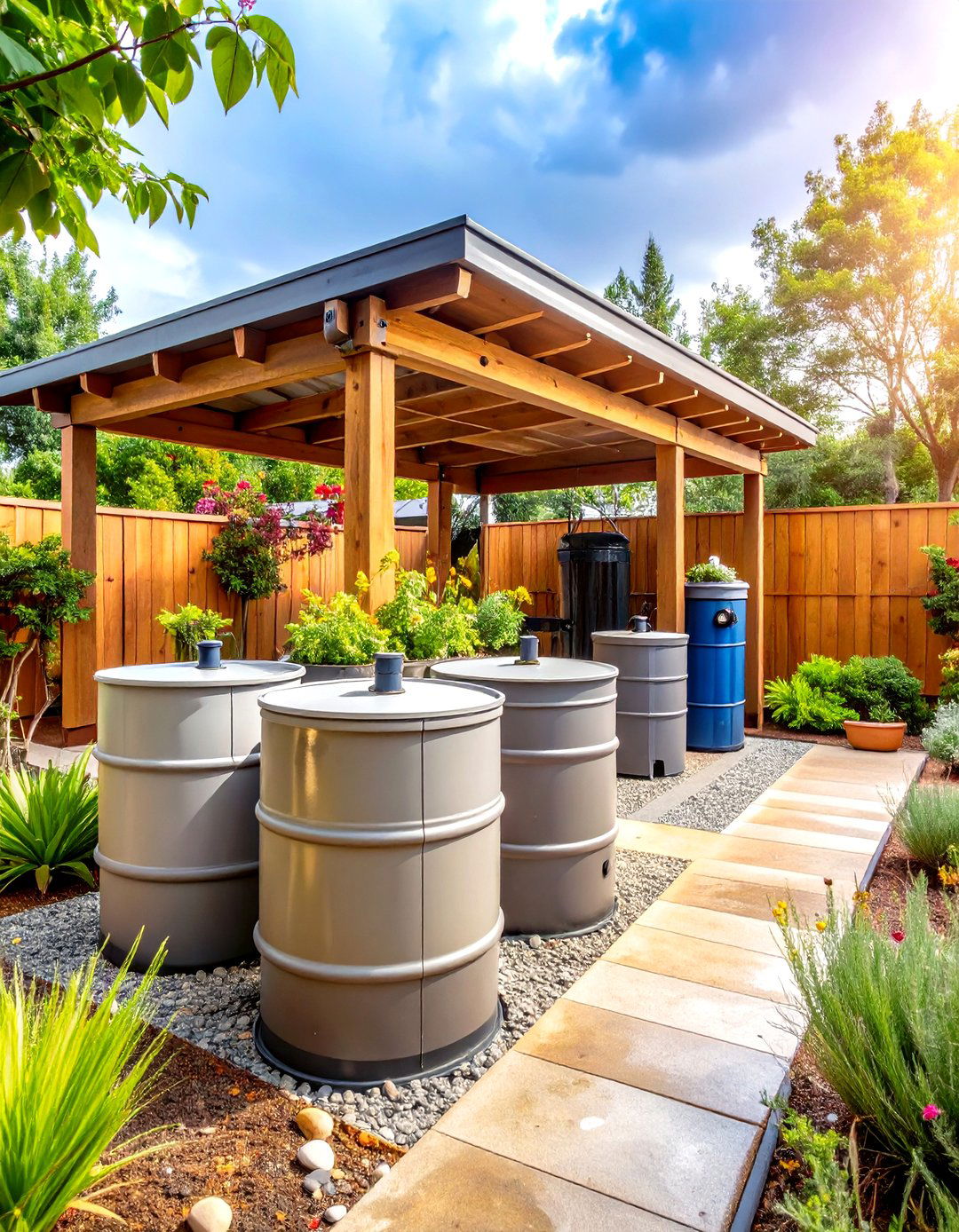
Demonstrate environmental stewardship through a comprehensive water conservation garden that teaches sustainable resource management. This school garden design features rainwater harvesting systems, greywater recycling, drought-tolerant plants, and water-wise irrigation methods. Install rain barrels, cisterns, and collection systems that capture water from school buildings for garden irrigation. Create demonstration areas showing different watering techniques including drip irrigation, soaker hoses, and mulching strategies. Plant native, drought-resistant species that require minimal water inputs while providing educational value. Include measurement stations for tracking rainfall, water usage, and plant moisture needs. Design permeable pathways that allow water infiltration and prevent runoff. Add educational signage explaining water cycles, conservation principles, and environmental impact. This sustainable design teaches students about resource conservation, climate adaptation, and responsible environmental practices while demonstrating practical solutions for water scarcity challenges facing communities worldwide.
11. School Garden Community Market Enterprise
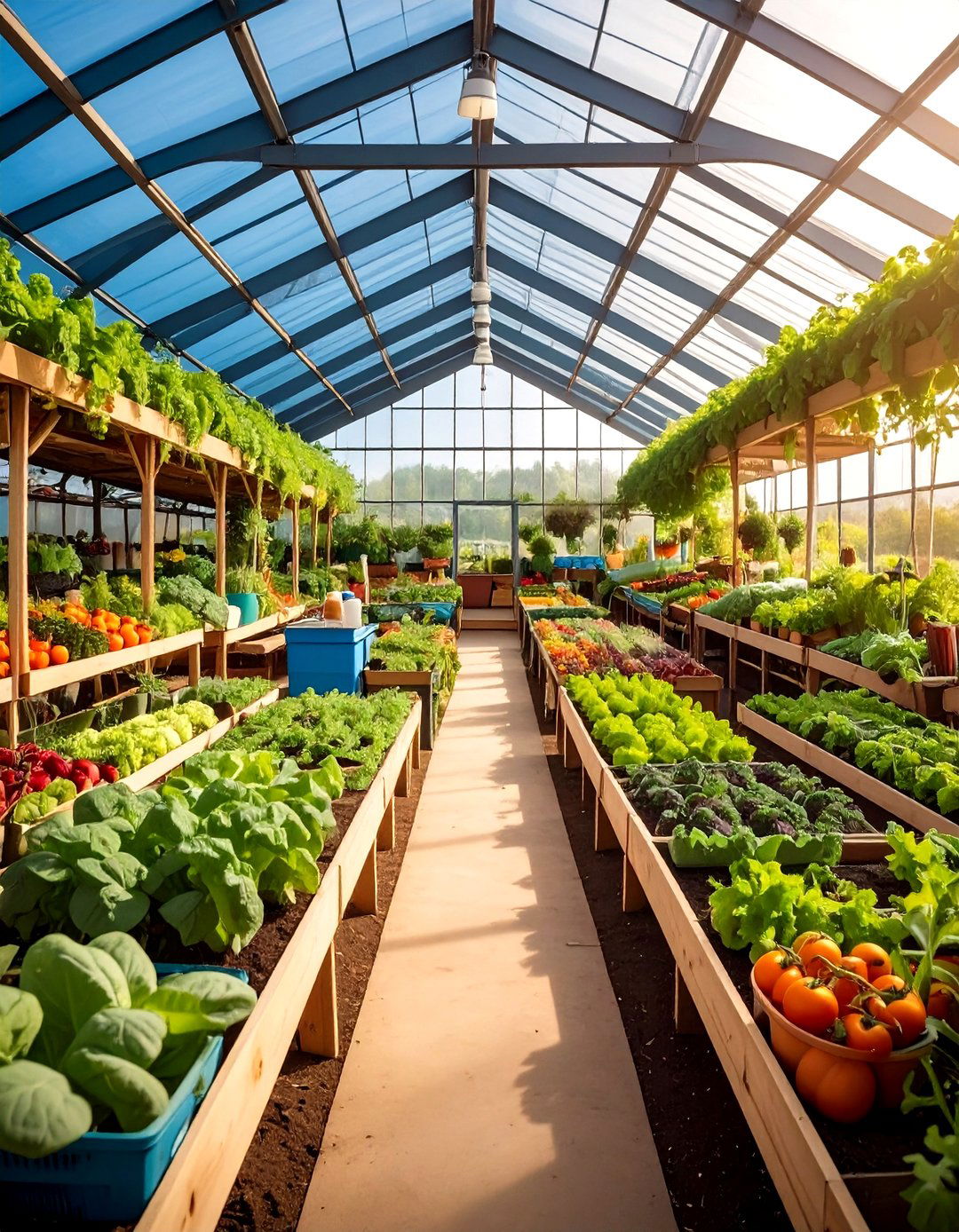
Create an entrepreneurial learning environment where students experience the full cycle of agricultural production, marketing, and sales. This school garden design includes diverse crop production areas, harvest processing stations, and market preparation spaces where students learn business principles through hands-on experience. Plant high-yield crops suitable for farmers market sales including herbs, salad greens, flowers, and specialty vegetables. Include washing and packaging stations where students prepare produce for sale. Create educational displays explaining pricing, profit calculations, and customer service skills. Design attractive display areas for student-run farmers markets and community sales events. Install storage areas for tools, supplies, and harvested produce. Include record-keeping stations where students track expenses, revenues, and profit margins. This business-focused approach teaches students about agricultural economics, entrepreneurship, and community connections while providing real-world applications for math, communication, and problem-solving skills. Students gain confidence through meaningful work that benefits their school and local community.
12. School Garden Medicinal Plants Learning Center
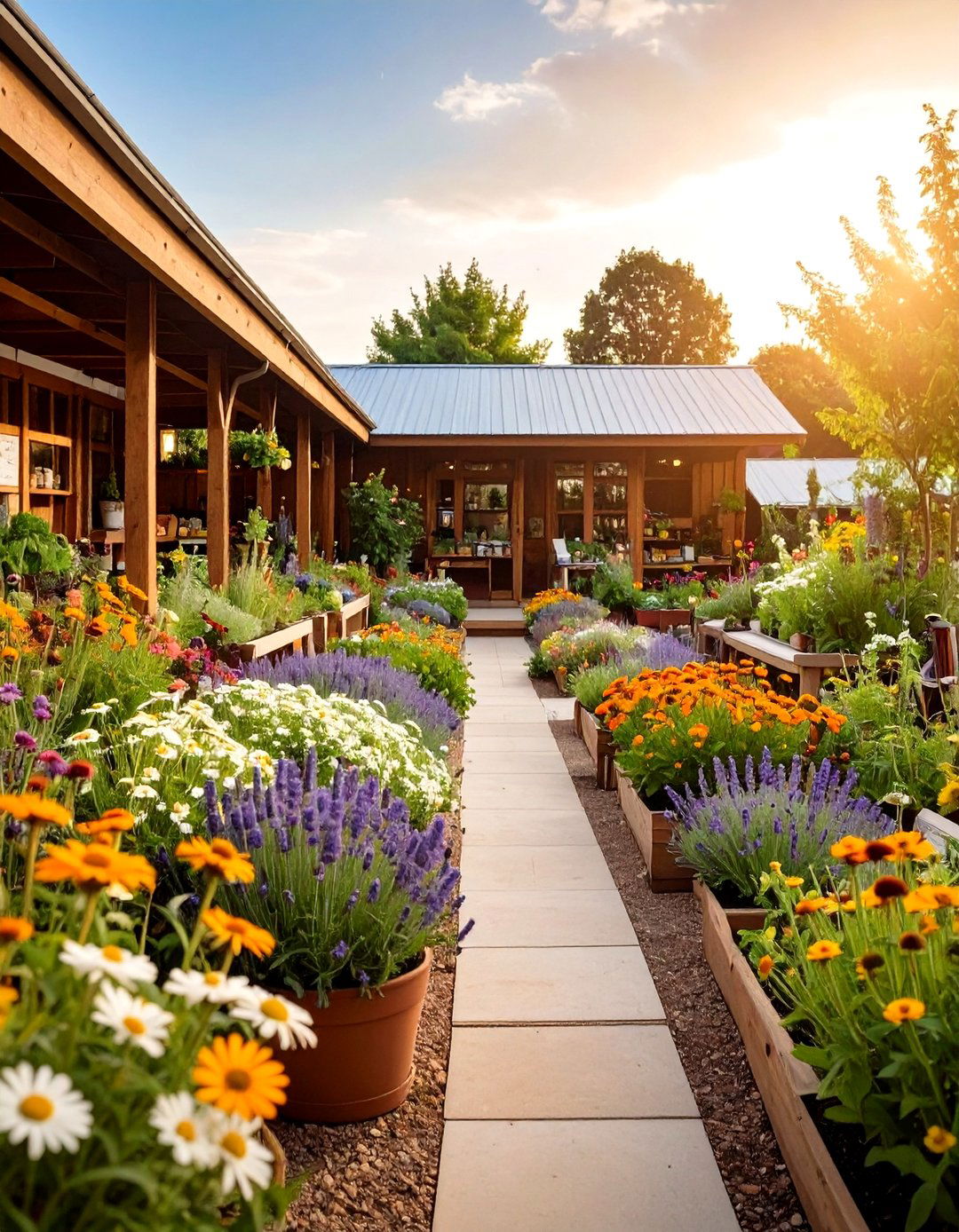
Introduce students to the healing properties of plants through a carefully designed medicinal garden that teaches botanical science and traditional plant medicine. This school garden concept features safe, educational herbs and plants with documented medicinal properties including chamomile, calendula, echinacea, and lavender. Create educational stations explaining plant chemistry, traditional uses, and modern research about plant-based medicine. Include herb processing areas where students can safely dry plants, make herbal teas, and prepare simple remedies under supervision. Design the space with clear labeling and safety protocols ensuring students understand the importance of proper plant identification and usage guidelines. Install research areas where students can study plant properties and document their observations. Include historical information about traditional medicine practices from various cultures. This educational approach teaches students about botany, chemistry, and cultural traditions while emphasizing safety, scientific research, and respect for traditional knowledge systems.
13. School Garden Alphabet Learning Adventure
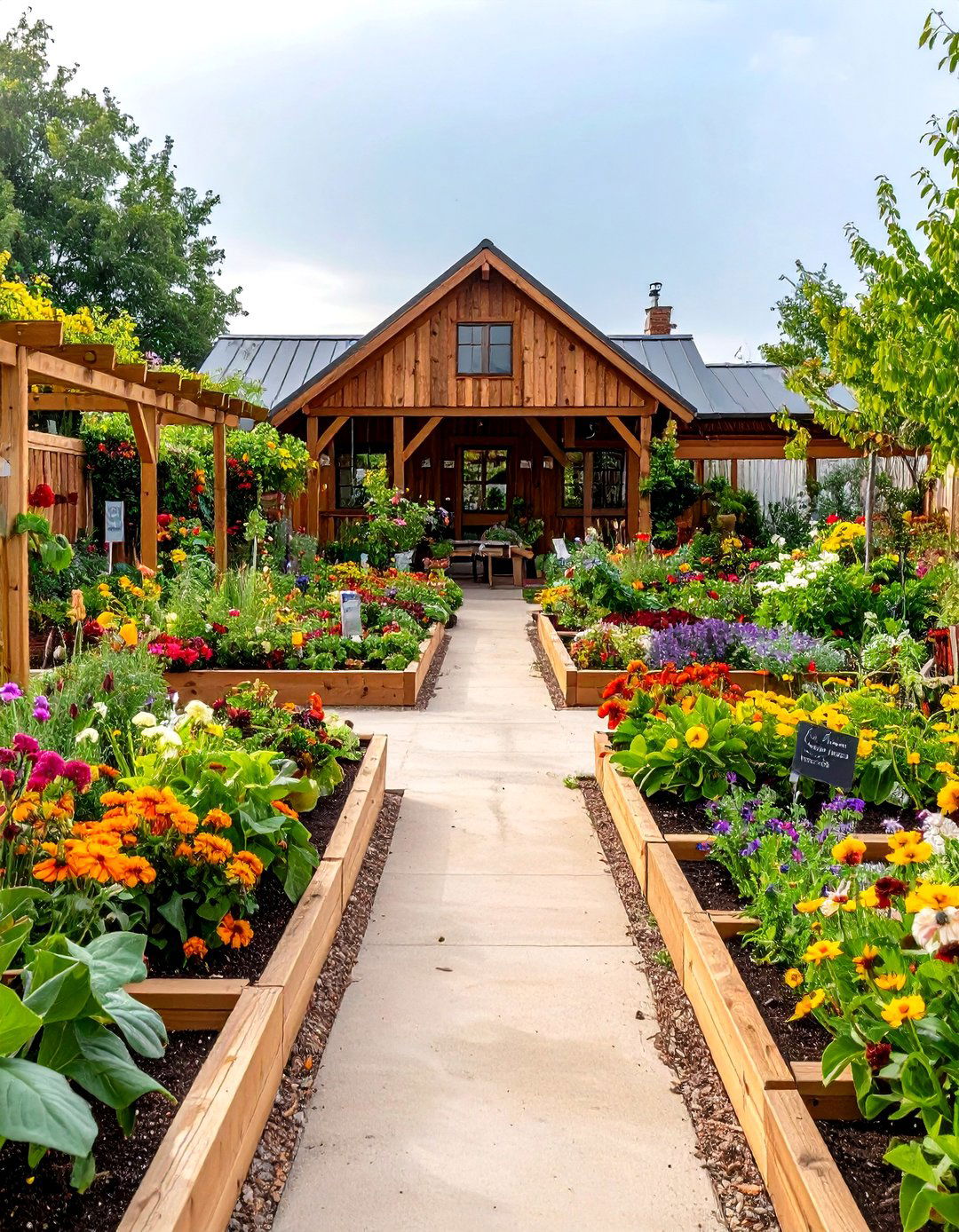
Design an engaging garden that supports early literacy development by organizing plants alphabetically and creating letter-themed growing areas. This school garden concept features 26 distinct planting areas, each showcasing plants that begin with different letters of the alphabet. Plant apples, beans, carrots, dill, eggplant, and flowers through the entire alphabet, creating opportunities for vocabulary development and letter recognition. Include reading areas with weather-resistant books about plants and gardening topics. Create letter-shaped garden beds or decorative signs that reinforce letter recognition while students explore different plant varieties. Install measurement activities that incorporate counting, sorting, and basic math skills alongside literacy learning. Design storytelling areas where students can share observations and create narratives about their garden experiences. This literacy-focused approach supports early childhood education while making learning interactive and memorable. Students develop reading skills, expand vocabulary, and strengthen letter recognition through direct experience with plants and nature-based learning activities.
14. School Garden Seasons Discovery Calendar
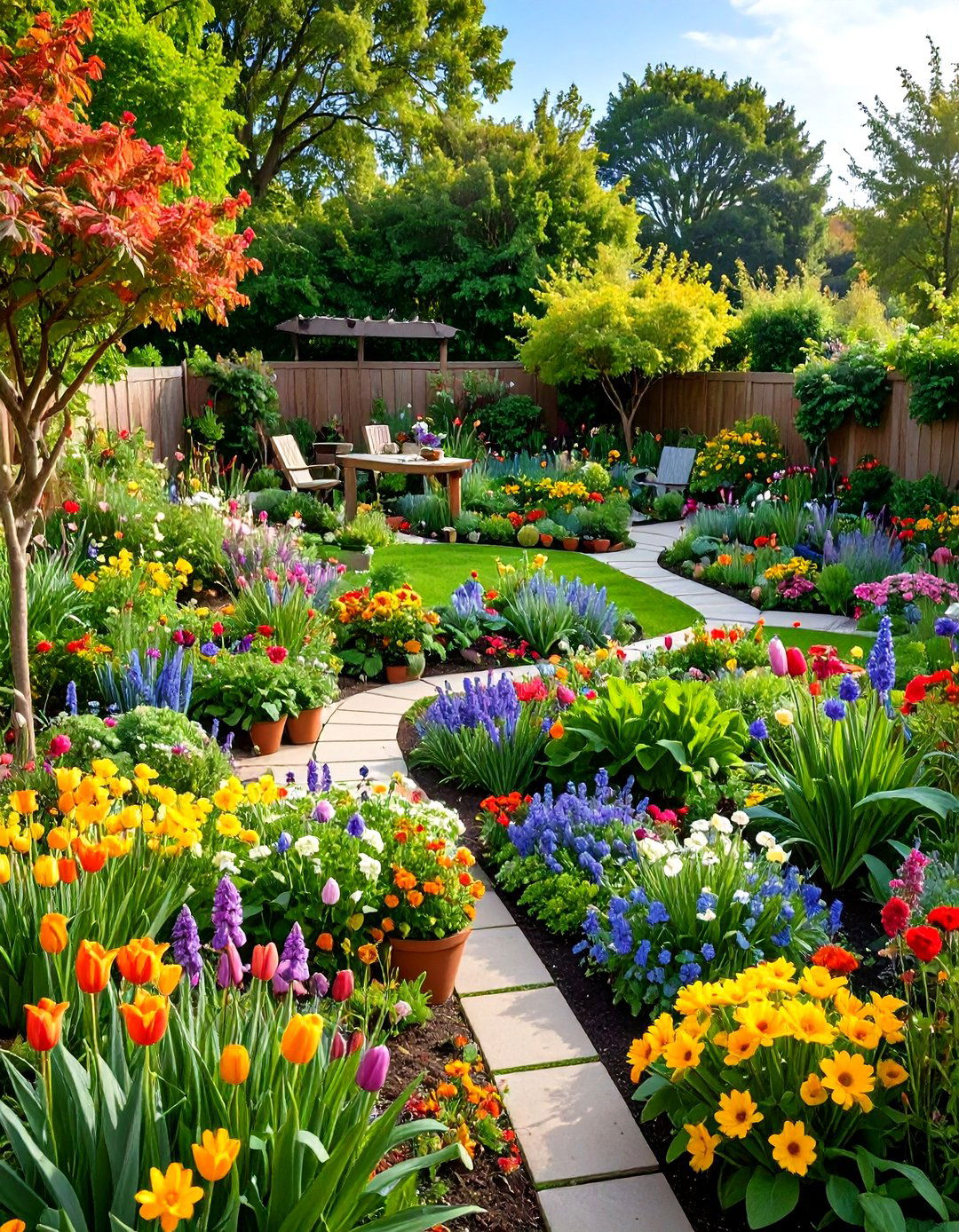
Create an educational garden that demonstrates seasonal changes and helps students understand natural cycles throughout the year. This school garden design features plants that highlight different seasons through blooming times, harvest periods, and visual changes. Plant spring bulbs, summer flowers, fall vegetables, and winter interest plants that provide year-round educational opportunities. Include weather monitoring stations where students track temperature, precipitation, and daylight hours alongside plant responses. Create seasonal activity areas for different types of garden work including spring planting, summer maintenance, fall harvesting, and winter planning. Install observation journals and recording stations where students document seasonal changes and plant development. Design the space with seasonal decorations and educational displays that change throughout the year. Include preservation activities like seed saving, food drying, and winter preparation that extend learning beyond the growing season. This temporal approach teaches students about natural cycles, climate patterns, and seasonal adaptation while providing continuous learning opportunities regardless of weather conditions.
15. School Garden Composting Ecosystem Education
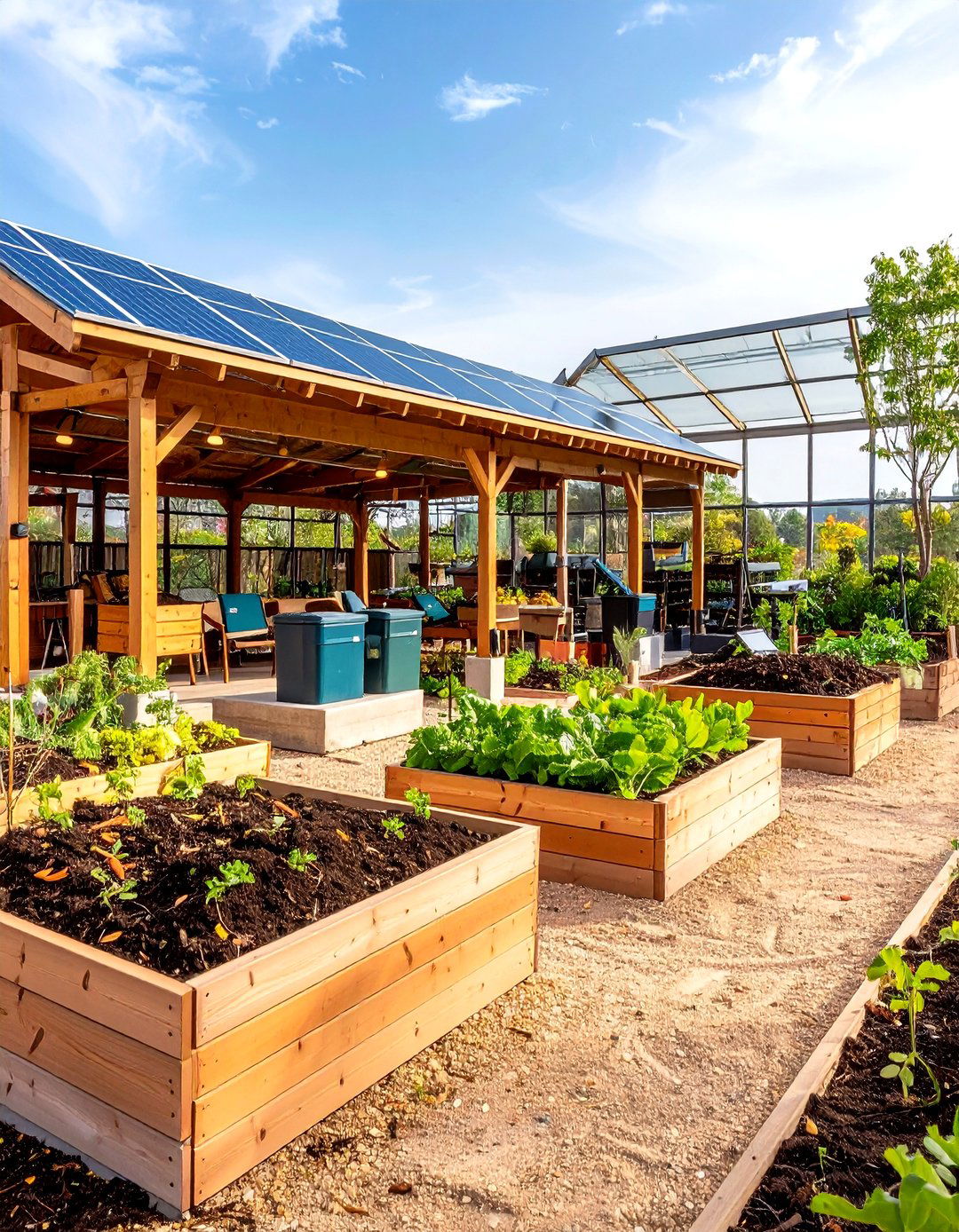
Transform organic waste into learning opportunities through a comprehensive composting system that teaches decomposition, nutrient cycling, and waste reduction. This school garden design features multiple composting methods including traditional bins, vermicomposting with worms, and leaf mold systems. Create educational stations explaining decomposition processes, soil health, and nutrient cycling in natural ecosystems. Include microscope areas where students can observe soil organisms and decomposer activity. Design the space with clear labeling showing different stages of composting and proper waste sorting techniques. Install temperature monitoring equipment and turning systems that students can operate safely. Create measurement areas where students can track composting progress and test finished compost quality. Include demonstration plots showing the difference between plants grown with and without compost amendments. This systems-thinking approach teaches students about waste reduction, soil science, and environmental cycles while providing practical life skills and environmental stewardship values that extend beyond the garden into home and community practices.
16. School Garden Native Wildlife Habitat Sanctuary
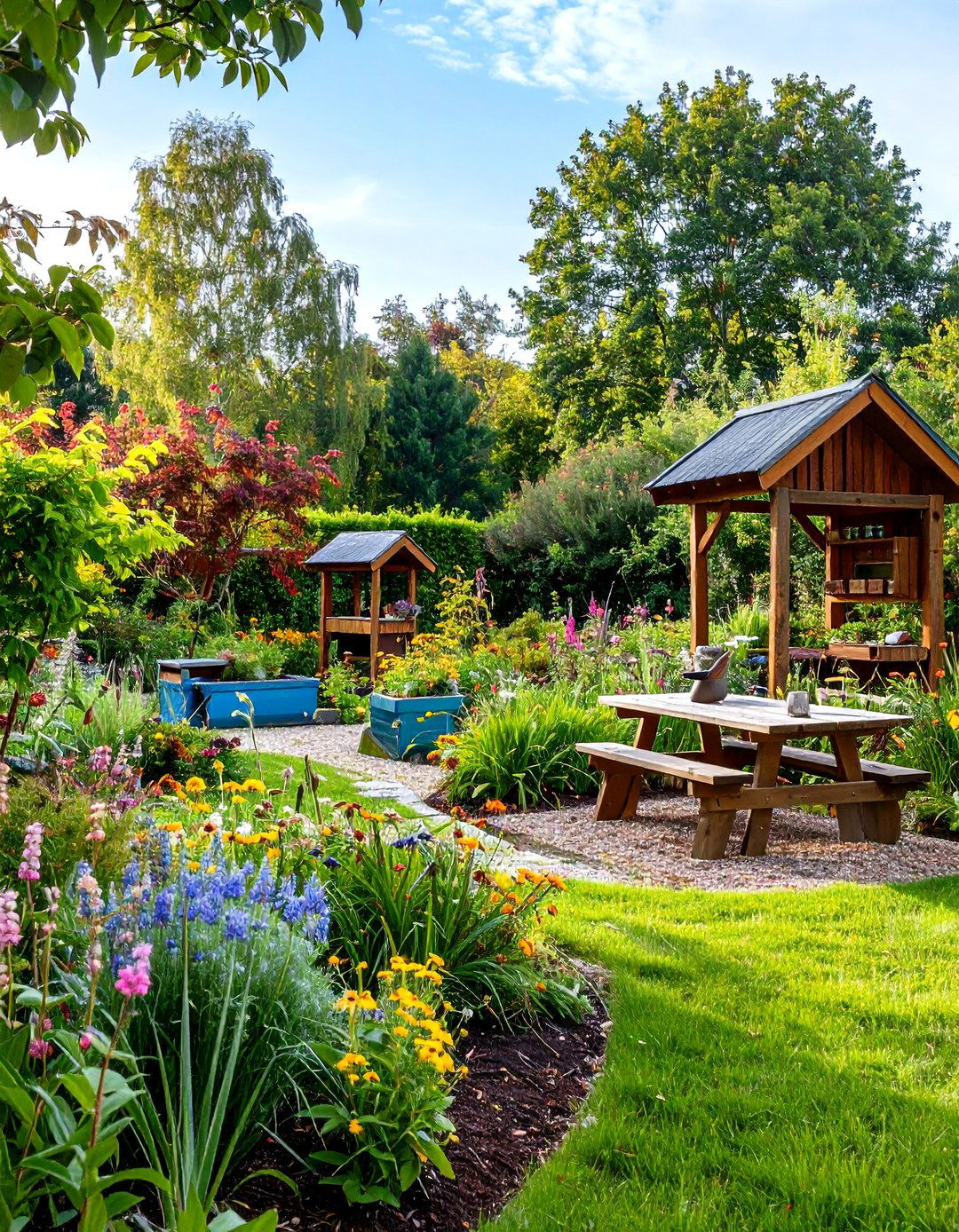
Design a garden ecosystem that supports local wildlife while teaching students about biodiversity, habitat requirements, and conservation practices. This school garden concept features native plants, water sources, shelter areas, and food sources that attract birds, beneficial insects, small mammals, and other local wildlife. Plant native trees, shrubs, and wildflowers that provide seasonal food sources and nesting materials. Include bird feeding stations, nesting boxes, and water features that support wildlife needs throughout the year. Create observation blinds and quiet areas where students can watch wildlife behavior without disturbance. Install identification guides and recording stations where students can document wildlife sightings and behavioral observations. Design the space with minimal human intervention areas that allow natural processes to occur. Include educational signage explaining habitat requirements, migration patterns, and conservation challenges facing local wildlife. This ecological approach teaches students about ecosystem relationships, biodiversity importance, and conservation practices while creating beautiful, dynamic outdoor learning environments that change with seasons and wildlife activity.
17. School Garden Historical Founders Heritage
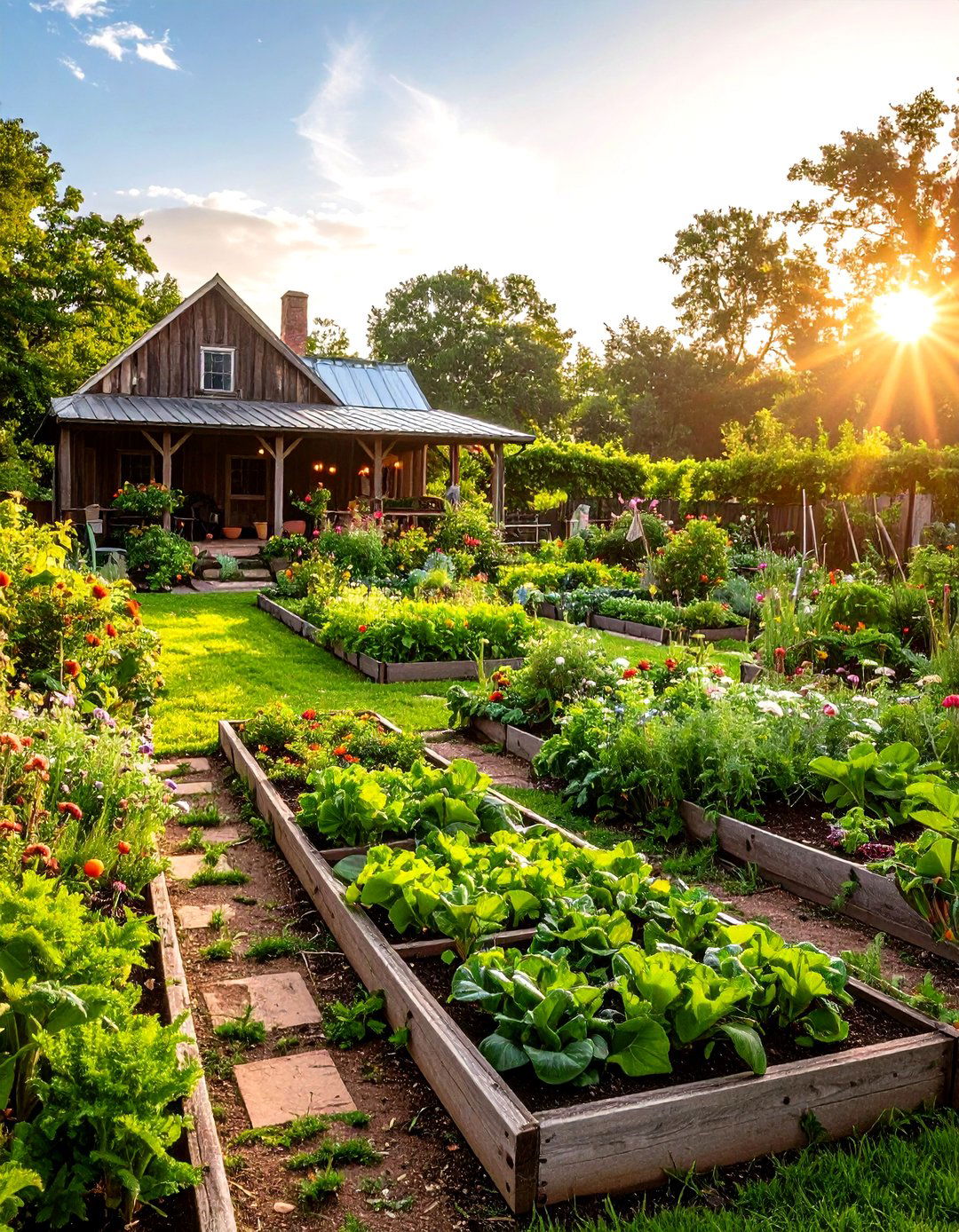
Connect students to American agricultural history by recreating gardens inspired by founding fathers and historical agricultural practices. This school garden design features heritage varieties and growing methods used by historical figures like George Washington and Thomas Jefferson. Plant heirloom vegetables, historic apple varieties, and crops that were important in early American agriculture. Create educational areas explaining historical farming techniques, tool usage, and agricultural challenges faced by early settlers. Include demonstrations of traditional preservation methods like root cellaring, seed saving, and food drying. Design the space with period-appropriate tools, structures, and growing methods that students can experience firsthand. Install interpretive materials explaining how agriculture shaped American history, westward expansion, and economic development. Include comparison areas showing how modern agriculture differs from historical practices. This historical approach teaches students about American heritage, agricultural development, and the evolution of farming practices while connecting past and present through hands-on experience with traditional growing methods and heritage plant varieties.
18. School Garden Cooking Adventure Kitchen
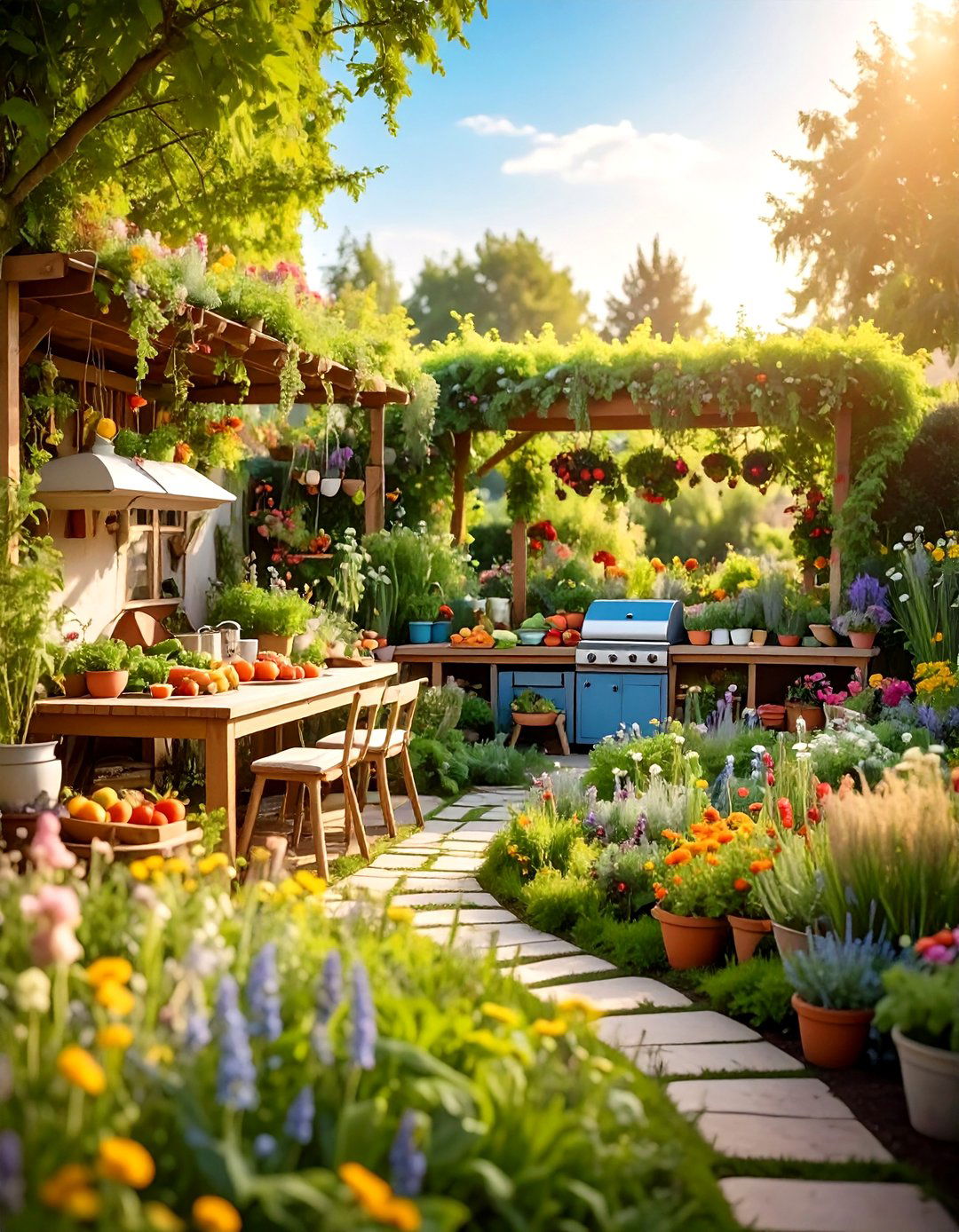
Create an integrated garden-to-table experience that combines food production with culinary education and nutrition learning. This school garden design features diverse food crops organized by cooking categories including fresh eating, cooking ingredients, and preservation varieties. Include outdoor kitchen facilities with safe cooking equipment, preparation areas, and storage for cooking tools and ingredients. Plant herbs for seasoning, vegetables for main dishes, and fruits for desserts creating complete meal possibilities from garden harvests. Create recipe development areas where students can experiment with cooking techniques and flavor combinations. Include food safety education stations teaching proper washing, preparation, and cooking methods. Design the space with seating areas for outdoor dining and food sharing experiences. Install preservation equipment for canning, drying, and freezing excess harvests. This culinary approach teaches students about nutrition, cooking skills, and food safety while connecting garden work to practical life skills. Students develop confidence in food preparation and gain appreciation for fresh, locally grown ingredients.
19. School Garden Art Integration Studio
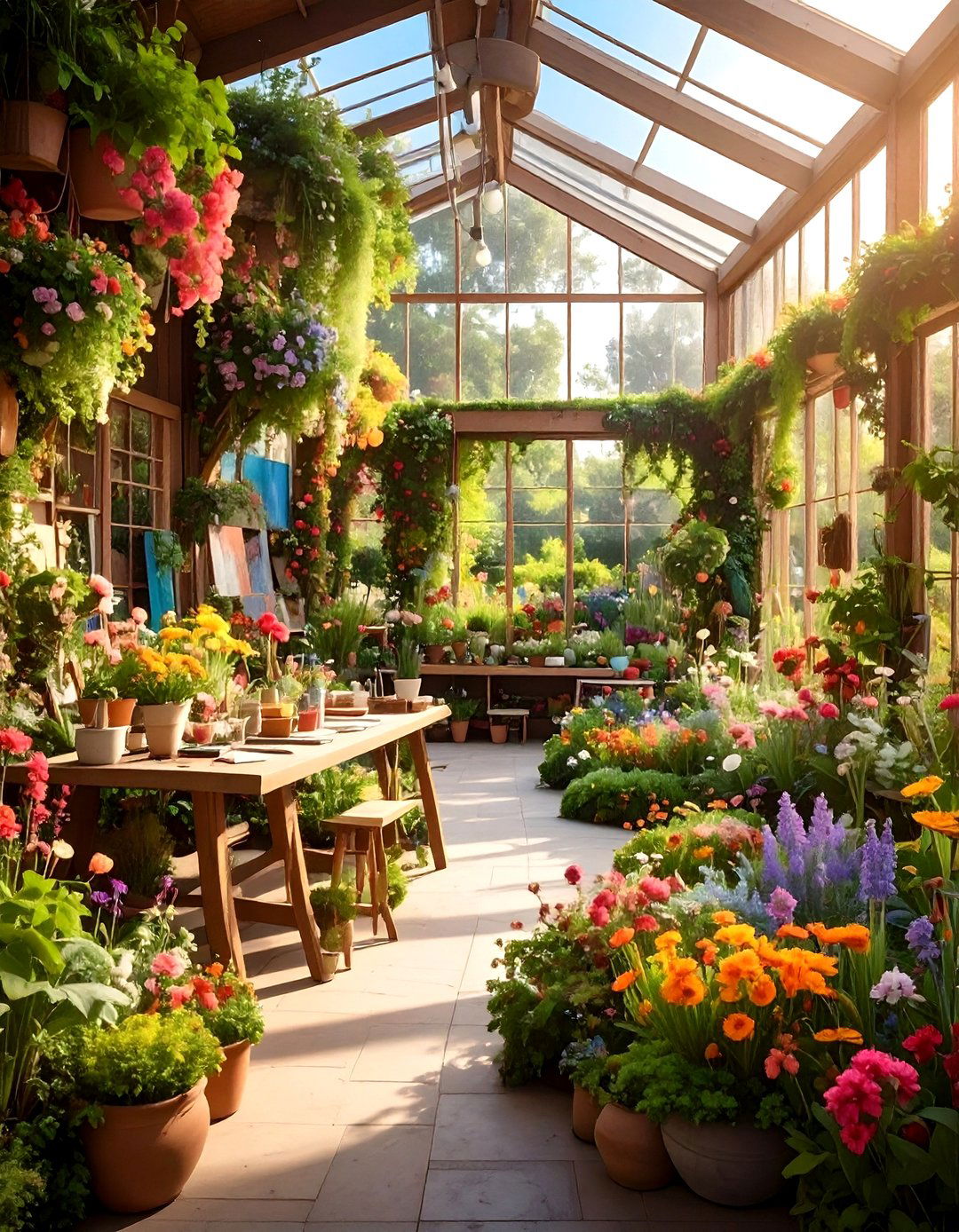
Combine visual arts education with gardening through a design that emphasizes color, texture, form, and creative expression using plants and garden materials. This school garden concept features plants chosen for their artistic qualities including colorful flowers, interesting foliage patterns, and sculptural growth forms. Create outdoor art studios where students can use natural materials for painting, sculpture, and craft projects. Include dye gardens with plants that produce natural colors for textile arts and painting projects. Design the space with living sculptures, topiary projects, and garden installations that students create and maintain. Install weather-resistant art displays where students can showcase garden-inspired artwork and creative projects. Create photography areas with interesting backgrounds and lighting for documenting garden art and plant studies. Include seasonal art projects that change with garden development and harvest cycles. This creative approach integrates visual arts standards with science education while encouraging artistic expression and creativity. Students develop aesthetic appreciation for natural beauty while learning about plant characteristics and garden design principles.
20. School Garden Wellness Retreat Sanctuary

Design a peaceful garden space that promotes mental health, stress reduction, and mindfulness while teaching students about the therapeutic benefits of nature. This school garden concept features calming plants, quiet seating areas, and meditative pathways that create a restorative outdoor environment. Plant aromatic herbs, soft-textured plants, and species known for their calming properties including lavender, mint, and chamomile. Create meditation circles, reading nooks, and quiet reflection areas where students can process emotions and practice mindfulness. Include sensory elements like wind chimes, water features, and textured pathways that promote relaxation and sensory awareness. Design the space with natural materials, earth tones, and organic shapes that create peaceful, welcoming atmospheres. Install journaling stations where students can write about their garden experiences and emotional responses to nature. Include yoga or movement areas for gentle physical activity and stress relief. This wellness-focused approach teaches students about mental health, stress management, and the healing power of nature while providing essential emotional support and coping strategies through garden-based therapy and mindfulness practices.
Conclusion:
School gardens offer limitless possibilities for creating engaging, educational outdoor learning environments that benefit students, schools, and communities. From science laboratories to cultural celebrations, these diverse design concepts demonstrate how gardens can support curriculum goals while fostering environmental stewardship and practical life skills. Whether implementing container systems for limited spaces or creating expansive habitat sanctuaries, successful school gardens combine thoughtful planning with community support to create lasting educational impact. By choosing designs that match their specific goals, resources, and student populations, schools can cultivate thriving garden programs that inspire lifelong learning and environmental responsibility while providing hands-on experiences that make education memorable and meaningful.





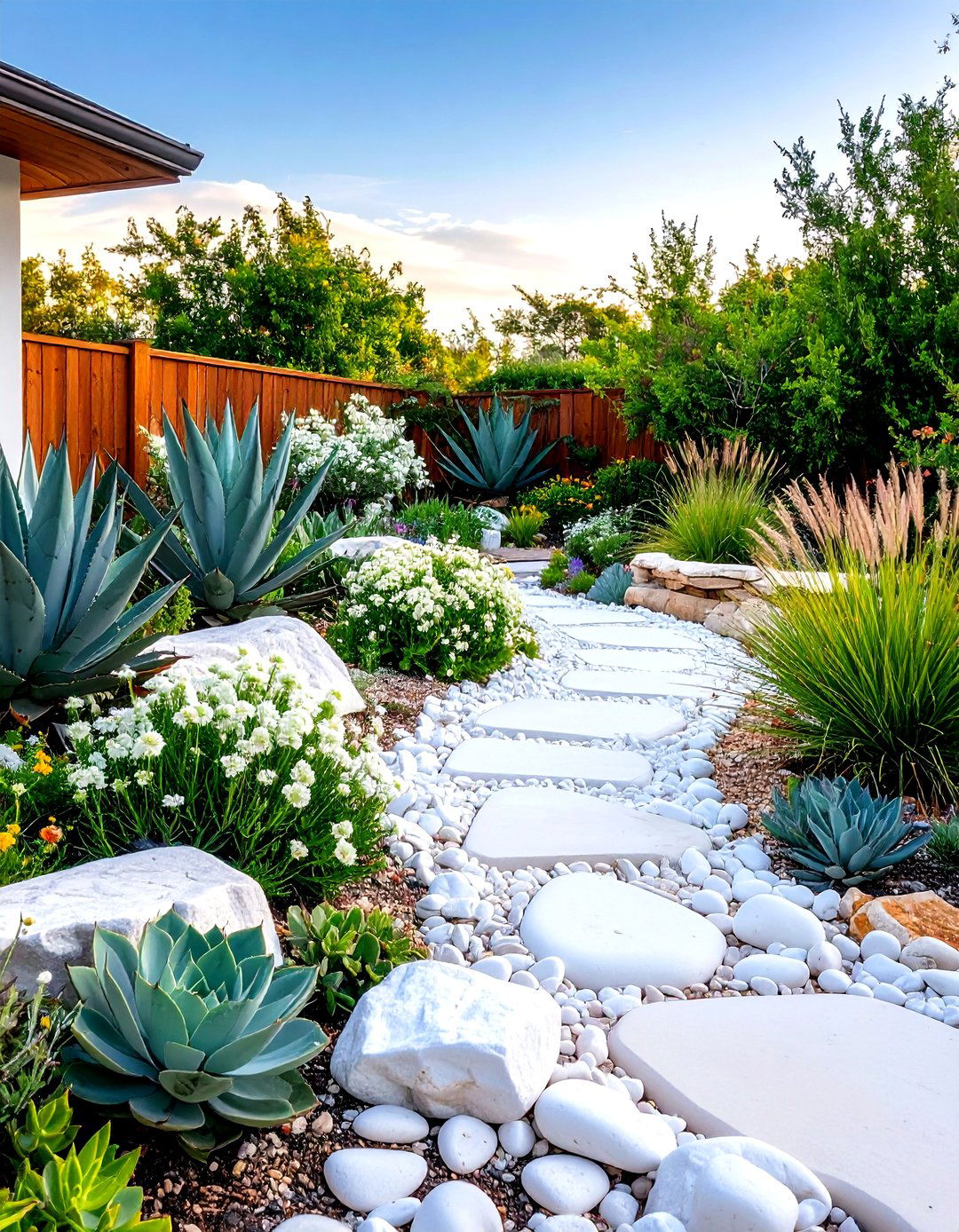






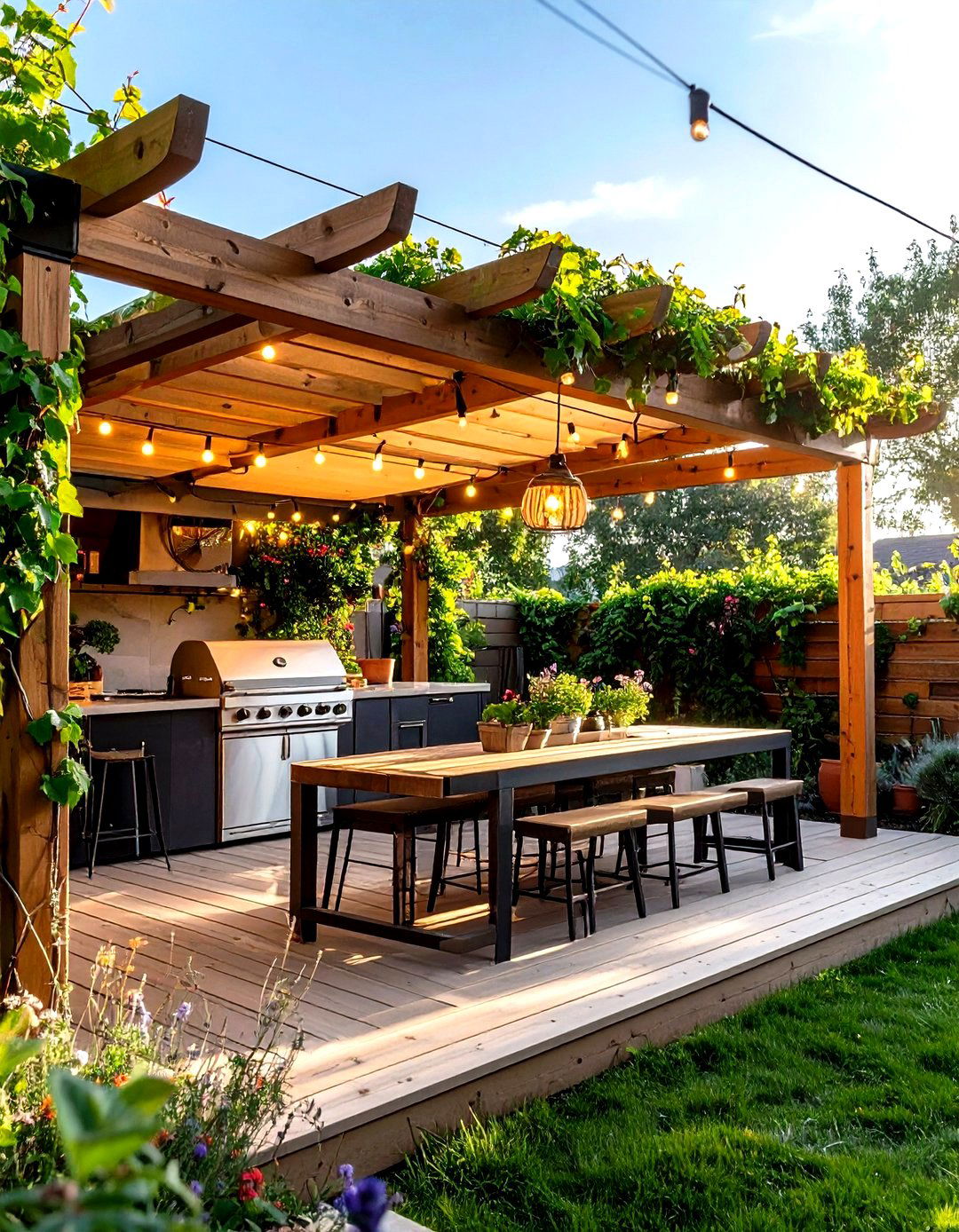

Leave a Reply